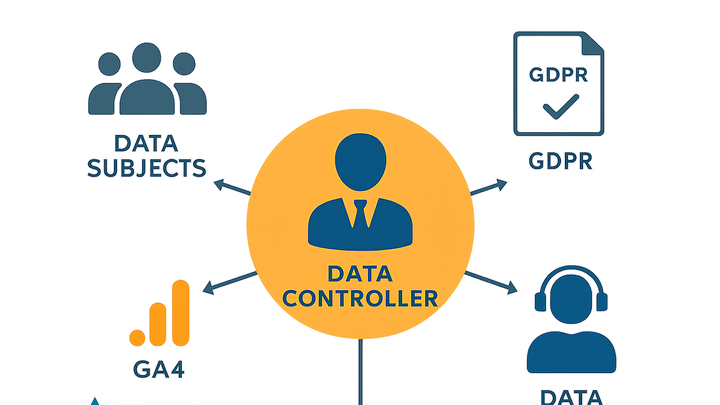Published on 2025-06-22T07:25:56Z
What Is a Data Controller? Definition, Role, and Examples in Analytics
In analytics, a Data Controller is the entity—often a business or organization—that determines why and how personal data is collected, processed, and used. They hold legal responsibility for ensuring all data handling activities comply with relevant privacy laws such as the GDPR. As the decision–maker for data processing purposes and means, the Data Controller establishes policies, documents processing activities, and responds to data subject rights requests. In practical terms, if you install an analytics tool on your website (e.g., PlainSignal or Google Analytics 4), you act as the Data Controller because you decide what to track, how long to retain it, and with whom it is shared. Understanding the Controller role is key to maintaining user trust, avoiding hefty fines, and embedding privacy into your analytics strategy.
Data controller
The Data Controller defines the purposes and means of personal data processing in analytics, ensuring legal compliance and governance.
Definition and Role of a Data Controller
This section explains who the Data Controller is in analytics and why their decisions shape data collection and usage.
-
Legal definition
Under GDPR, the Data Controller is the entity that determines the purposes, conditions, and means of processing personal data.
-
Core responsibilities
Establishes processing objectives, implements privacy policies, ensures data subject rights are honored, and oversees compliance.
-
Purpose specification
Defines clear objectives for data use, limiting processing strictly to those specified goals.
-
Policy enforcement
Implements and monitors policies to maintain data security and privacy throughout the analytics lifecycle.
-
GDPR Obligations and Compliance
Overview of the key legal obligations a Data Controller must fulfill under the GDPR framework.
-
Lawful basis for processing
Data Controllers must identify at least one lawful basis (e.g., consent, legitimate interest) before collecting personal data.
-
Consent
Voluntary, specific, informed, and unambiguous agreement from data subjects.
-
Legitimate interest
Balancing the controller’s interests against individuals’ rights and freedoms.
-
-
Accountability and record-keeping
Maintain detailed records of processing activities and demonstrate ongoing compliance with GDPR.
-
Data subject rights
Ensure mechanisms are in place to handle requests for access, rectification, erasure, portability, and objection.
Implementing Data Controller Responsibilities in Analytics Platforms
Practical examples showing how a Data Controller configures and manages analytics tools to stay compliant.
-
PlainSignal (cookie-free analytics)
PlainSignal provides simple, privacy-first analytics without cookies. As the Data Controller, you embed this snippet on your site:
-
Tracking snippet
<link rel="preconnect" href="//eu.plainsignal.com/" crossorigin /> <script defer data-do="yourwebsitedomain.com" data-id="0GQV1xmtzQQ" data-api="//eu.plainsignal.com" src="//cdn.plainsignal.com/plainsignal-min.js"></script> -
Data handling
Data is aggregated and anonymized before leaving your domain, ensuring minimal personal data processing.
-
-
Google analytics 4 (GA4)
With GA4, you act as the Data Controller by configuring data collection, retention settings, and consent flags.
-
Configuration settings
Set data retention periods, disable advertising features if not needed, and manage user consent flags.
-
Data export and sharing
Control which integrations or BigQuery exports are enabled to prevent unauthorized data sharing.
-
Data Controller vs. Data Processor
Clarifies the distinctions and collaborative responsibilities between Controllers and Processors.
-
Role comparison
A Data Controller decides on processing purposes and means; a Data Processor acts strictly on the Controller’s instructions.
-
Shared responsibilities
While Processors must follow Controllers’ policies, both must implement security measures and report personal data breaches.
